Family : Diodontidae

Text © Giuseppe Mazza

English translation by Mario Beltramini
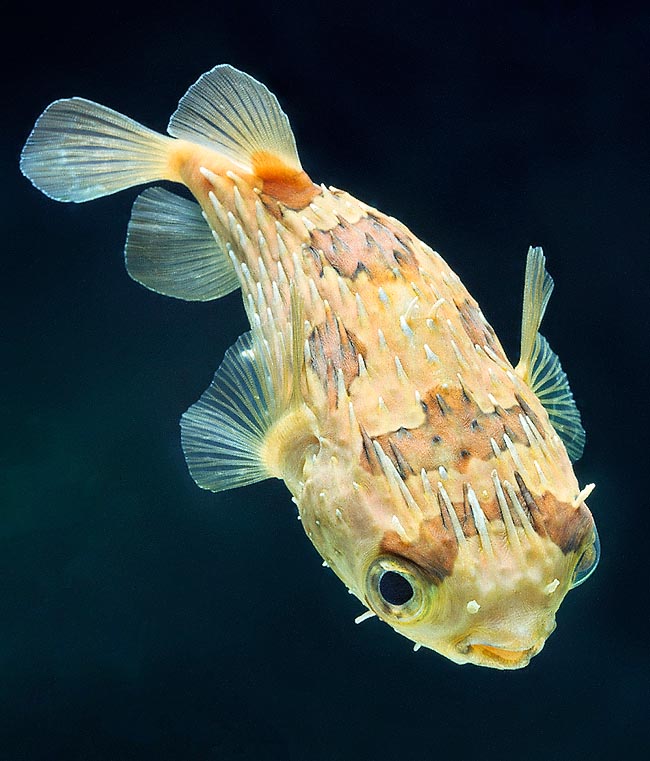
The Diodon holocanthus is a pantropical species present in all oceans © Giuseppe Mazza
Known as Balloonfish or Long-spine Porcupinefish, Diodon holocanthus Linnaeus, 1758, belongs to the class of the Actinopterygii, the ray-finned fishes, to the order of the Tetraodontiformes, and to the family of the Diodontidae, counting presently 7-8 genera, after the various authors, and about twenty species.
The name of the genus Diodon comes from the Greek “δίς” (dis) = two and “ὀδοντο” (odonto) = tooth, with the reference to the fact the two incisors, still present in the Tetraodontidae, during the long course of the evolution have merged in one only tooth on both jaws forming a sort of beak.
The name of the species holocanthus comes always from the Greek “ὅλος, ὁλο” (holos) = all and “ἄκανθα” (akantha) = spine, with clear allusion to the spines present over all its body.
Zoogeography
It is practically a pantropical species. As an indication, we find it from Florida, Brazil, and the Caribbean up to the African coasts and then going up from South Africa to Somalia and eastwards in India, Malaysia, Indonesia, Philippines, Japan, Australia and all Oceania to finally reach Ecuador and Chile.
Ecology-Habitat
The Diodon holocanthus is frequent in the coralligenous formations between 2 and 35 m of depth, but can go down up to 200 m. It swims along the rocky coasts, in the submerged grasslands, close to the estuaries and in very shallow waters among the roots of the mangroves rich of molluscs. Shy and solitary, but at times even in dense groups, flees from the sight of the divers.
Morphophysiology
It can reach the 50-60 cm even if usually does not exceed the 30 cm. The head is bulky and then the body tapers towards the caudal peduncle. The ventral fins are absent. When the fish swims slowly, exploring the bottom, the movement is mainly entrusted to the big pectoral fins, placed close to the gill slit, whilst the anal and the dorsal fins, symmetrical in a backward position, intervene with the caudal only when the animal flees towards a shelter or anyway is obliged to move quickly.
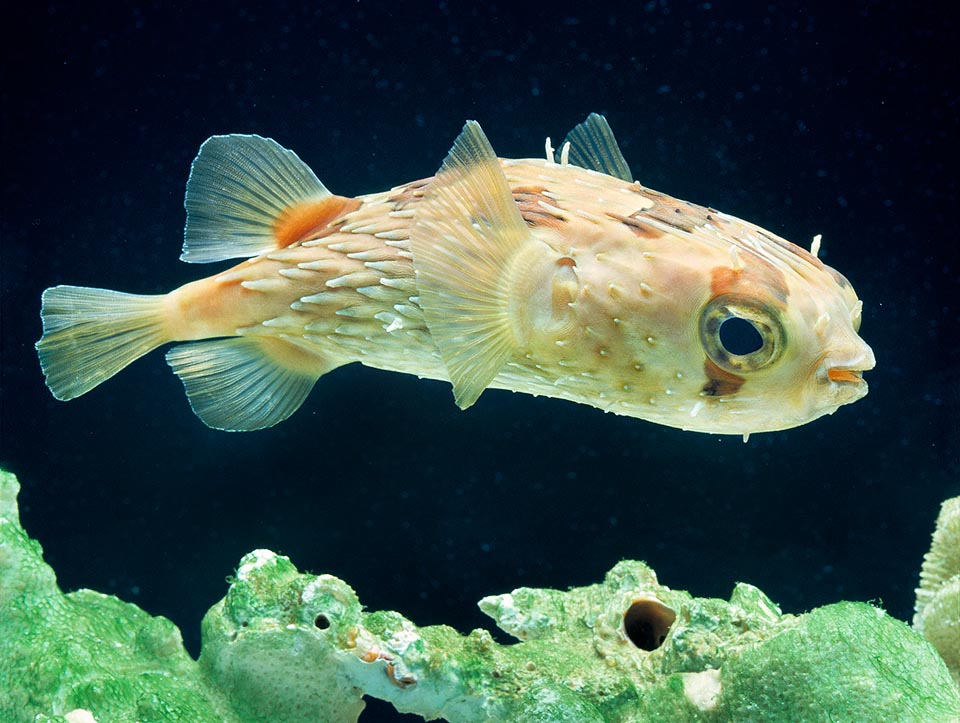
Usually 30 cm long, it has a mimetic livery and several spines scattered on the body that stand up when the fish inflates, in case of danger, gulping water or air © G. Mazza
With the evolution, the scales have transformed in erectile spines and like the other Diodon it can gulp down air or water, depending on the cases, transforming in a spiny vagrant ball difficult to grab.
The livery is clear, like golden sand, with irregular dark brown blotches having a mimetic function, such as the well marked one crossing, camouflaging them, the big protruding eyes, an often used trick in the world of the fishes to confuse the predators.
It distinguishes from the analogous Diodon hystrix, having no black band on the eye, also for the absence of dark blotches on the fins.
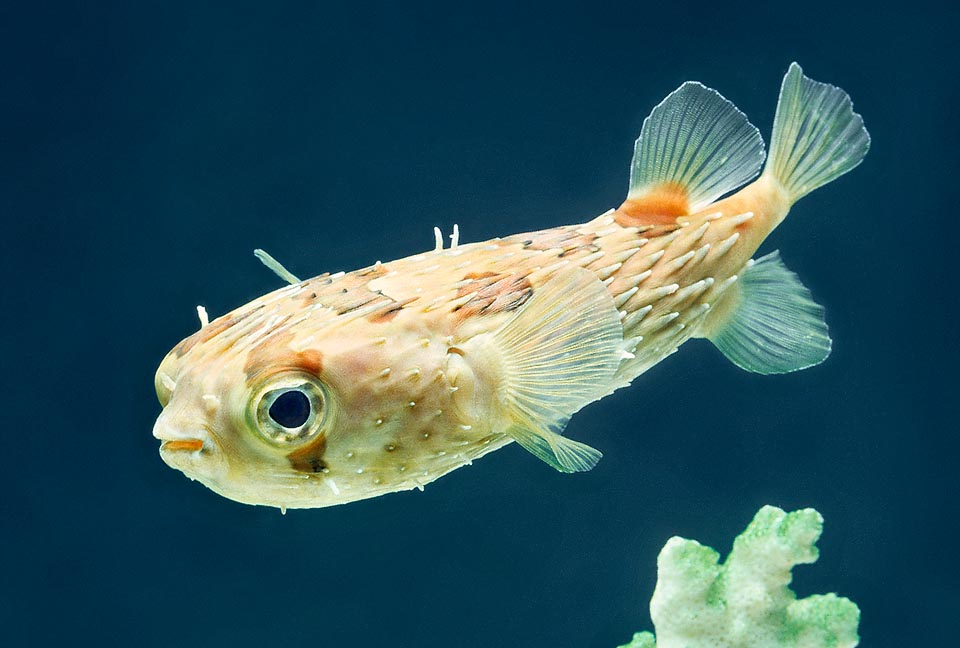
It has a powerful poison, the tetrodotoxin, that blocks the breathing. Cause of death also for the man, if badly prepared in the fugu, typical Japanese dish © Giuseppe Mazza
Like the other membres of the family it is offered in the fugu, typical Japanese dish, by skilled surgeon cooks, though imbued, especially in the ovaries and various internal organs, of tetrodotoxin, a very poisonous and lethal substance even for the man because it blocks the breathing. There are no antidotes and the only remedy, apart causing the patient to vomit, if he still has some food in the stomach, is the mechanical ventilation.
Ethology-Reproductive Biology
Besides the crustaceans it sights on the bottom and the bivalves it finds in the sand, crushed with the two teeth solid beak, the Diodon holocanthus nourishes of sea urchins, polyps of madrepores and other benthic invertebrates.
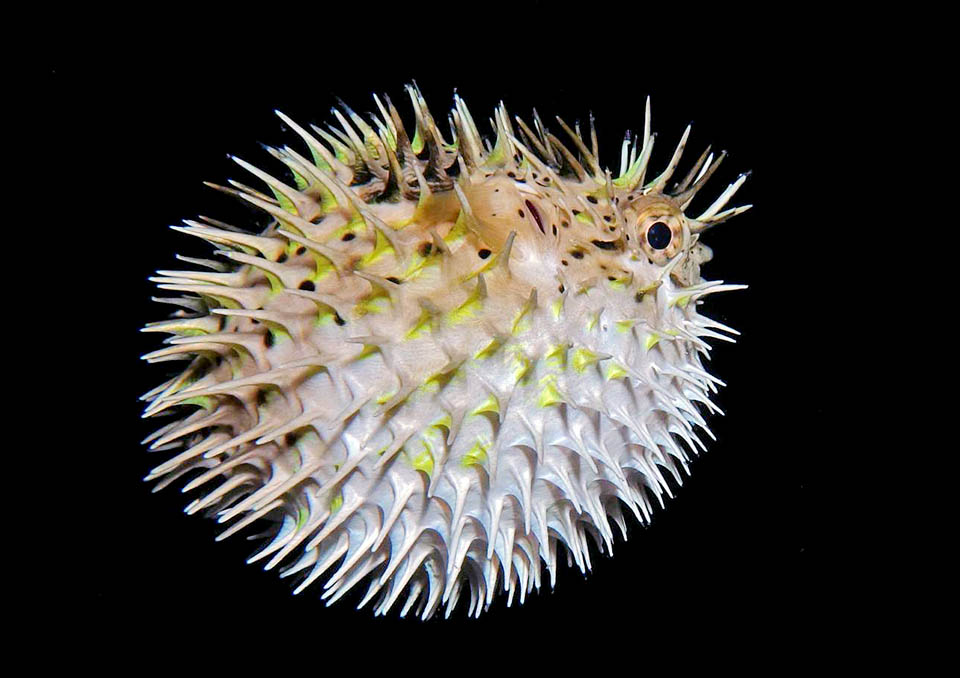
By swelling with water, this Diodon holocanthus appears larger and is less susceptible to predators © Patrick Randall
Once they have reached the adult size necessary for the reproduction, usually around the 30 cm, the females hatch floating spherical eggs, immediately fecundated by the male on duty. They abandoned to the oceanic currents and may cover even big distances during the 4 days of incubation, like the larvae carried by the waves and protected, for about ten days, by a thin shell that disappears as soon as the first spines show up. And it is thanks to this pelagic reproduction that a little a time the species has colonized the whole world.
The larval livery, yellow with red small dots, disappears by the end of the first month of life, when the small fishes begin to get the colours of the adults. The teeth form and the fins come but the young remain pelagic for a long time growing hidden among the drifting sargassos that offer them food and shelter. Then, when they reach the 7 cm, they approach the coasts and go down towards the bottom looking for a more substantial food.
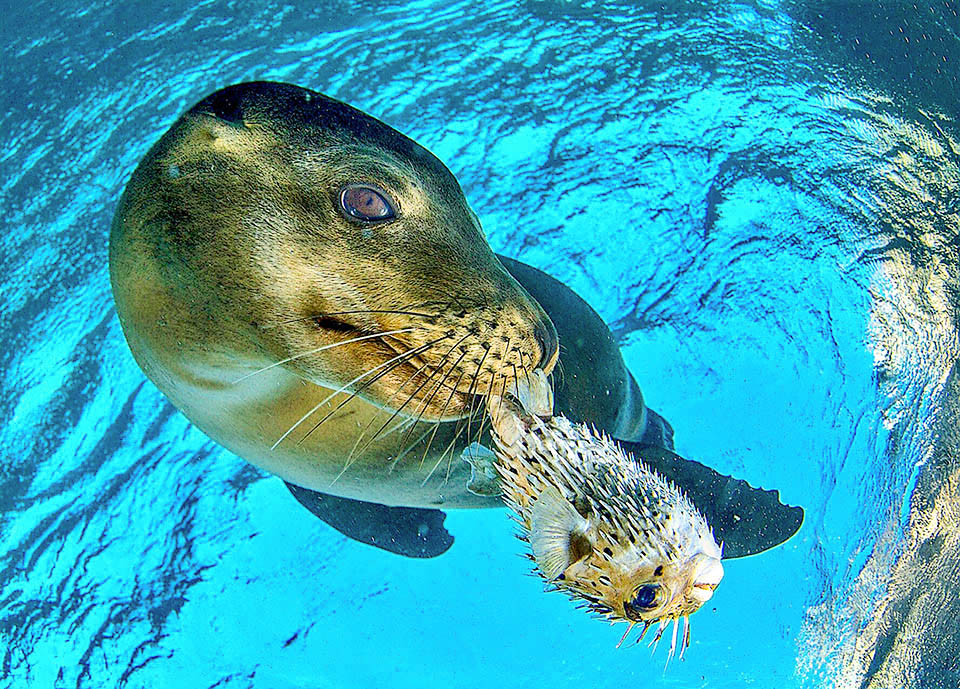
But that’s not enough for this California Fur Seal (Zalophus californianus) who grabs him by the tail © Luis Pérez Berrocal
When young this species is predated, apart the birds, by tunas and dolphins, whilst the adults are attacked by the sharks.
Apart from a few catches for the aquarium market or for escape, given its ability to double populations decimated by events in less than 15 months, its vast diffusion and its low vulnerability index to fishing which marks just 27 on a scale of 100, Diodon holocanthus has been listed since 2011 as “LC, Least Concern” in the IUCN Red List of endangered species.
Synonyms
Diodon hystrix holocanthus, Linnaeus, 1758; Diodon pilosus, Mitchill, 1815; Trichodiodon pilosus, Mitchill 1815; Diodon multimaculatus, Cuvier 1818; Diodon quadrimaculatus Cuvier, 1818; Paradiodon quadrimaculatus Cuvier, 1818; Diodon sexmaculatus, Cuvier, 1818; Diodon maculifer Kaup, 1855; Atopomycterus bocagei Steindachner, 1866; Diodon paraholocanthus Kotthaus, 1979.
→ For general information about FISH please click here.
→ For general information about BONY FISH please click here
→ For general information about CARTILAGINOUS FISH please click here.
→ To appreciate the BIODIVERSITY of BONY FISH please click here.
→ To appreciate the BIODIVERSITY of CARTILAGINOUS FISH please click here.
